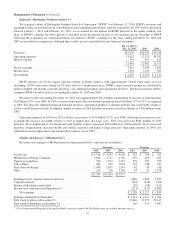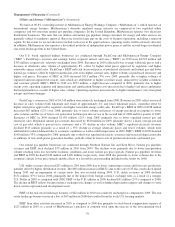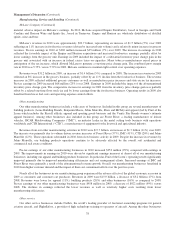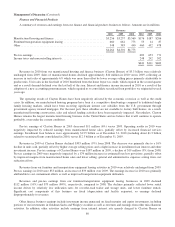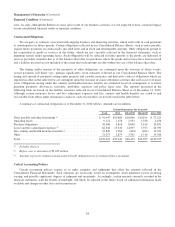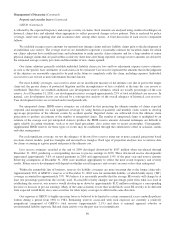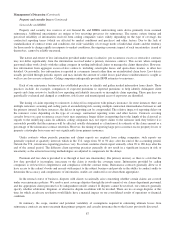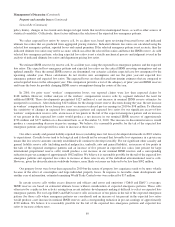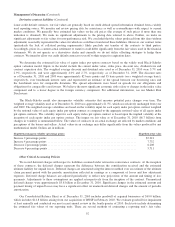Berkshire Hathaway 2010 Annual Report Download - page 87
Download and view the complete annual report
Please find page 87 of the 2010 Berkshire Hathaway annual report below. You can navigate through the pages in the report by either clicking on the pages listed below, or by using the keyword search tool below to find specific information within the annual report.
Management’s Discussion (Continued)
Property and casualty losses
A summary of our consolidated liabilities for unpaid property and casualty losses is presented in the table below. Except
for certain workers’ compensation reserves, liabilities for unpaid property and casualty losses (referred to in this section as
“gross unpaid losses”) are reflected in the Consolidated Balance Sheets without discounting for time value, regardless of the
length of the claim-tail. Amounts are in millions.
Gross unpaid losses Net unpaid losses *
Dec. 31, 2010 Dec. 31, 2009 Dec. 31, 2010 Dec. 31, 2009
GEICO ..................................................... $ 9,376 $ 8,561 $ 8,928 $ 8,211
General Re .................................................. 16,425 17,594 15,690 16,170
BHRG ..................................................... 29,124 28,109 24,422 23,150
Berkshire Hathaway Primary Group .............................. 5,150 5,152 4,802 4,774
Total ....................................................... $60,075 $59,416 $53,842 $52,305
* Net of reinsurance recoverable and deferred charges on reinsurance assumed and before foreign currency translation effects.
We record liabilities for unpaid losses and loss adjustment expenses under property and casualty insurance and reinsurance
contracts based upon estimates of the ultimate amounts payable under the contracts with respect to losses occurring on or before
the balance sheet date. The timing and amount of loss payments is subject to a great degree of variability and is contingent upon,
among other things, the timing of claim reporting from insureds and cedants and the determination of the ultimate amount
through the loss adjustment process. A variety of techniques are used in establishing the liabilities for unpaid losses. Regardless
of the techniques used, significant judgments and assumptions are necessary in projecting the ultimate amounts payable in the
future. As a result, uncertainties are imbedded in and permeate the actuarial loss reserving techniques and processes used.
As of any balance sheet date, not all claims that have occurred have been reported and not all reported claims have been
settled. Loss and loss adjustment expense reserves include provisions for reported claims (referred to as “case reserves”) and for
claims that have not been reported (referred to as incurred but not yet reported (“IBNR”) reserves). The time period between the
loss occurrence date and settlement payment date is referred to as the “claim-tail.” Property claims usually have fairly short
claim-tails and, absent litigation, are reported and settled within a few years of occurrence. Casualty losses usually have very
long claim-tails, occasionally extending for decades. Casualty claims are more susceptible to litigation and can be significantly
affected by changing contract interpretations. The legal environment further contributes to extending claim-tails.
Receivables are recorded with respect to losses ceded to other reinsurers and are estimated in a manner similar to liabilities
for insurance losses. In addition to the factors cited above, reinsurance recoverables may ultimately prove to be uncollectible if
the reinsurer is unable to perform under the contract. Reinsurance contracts do not relieve the ceding company of its obligations
to indemnify its own policyholders.
We utilize loss reserving techniques that are believed to best fit the particular business. Additional information regarding
reserving processes of our significant insurance businesses (GEICO, General Re and BHRG) follows.
GEICO
GEICO’s gross unpaid losses and loss adjustment expense reserves as of December 31, 2010 were $9.4 billion. Gross
reserves included $6.8 billion of reported average, case and case development reserves and $2.6 billion of IBNR reserves.
GEICO predominantly writes private passenger auto insurance which has a relatively short claim-tail. The key assumptions
affecting the setting of our reserves include projections of ultimate claim counts (“frequency”) and average loss per claim
(“severity”), which includes loss adjustment expenses.
Our reserving methodologies produce reserve estimates based upon the individual claims (or a “ground-up” approach),
which yields an aggregate estimate of the ultimate losses and loss adjustment expenses. Ranges of loss estimates are not
determined in the aggregate.
Our actuaries establish and evaluate unpaid loss reserves using recognized standard actuarial loss development methods
and techniques. The significant reserve components (and percentage of gross reserves as of December 31, 2010) are: (1) average
reserves (15%), (2) case and case development reserves (60%) and (3) IBNR reserves (25%). Each component of loss reserves
85


